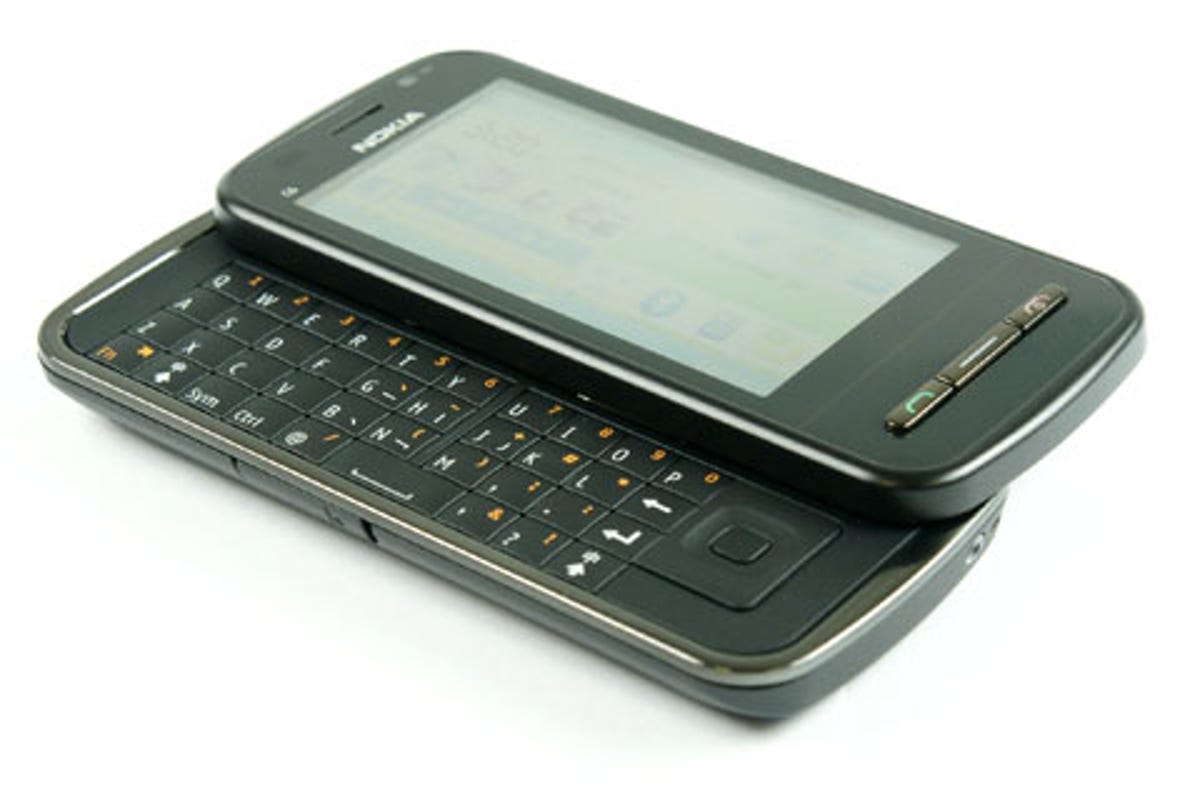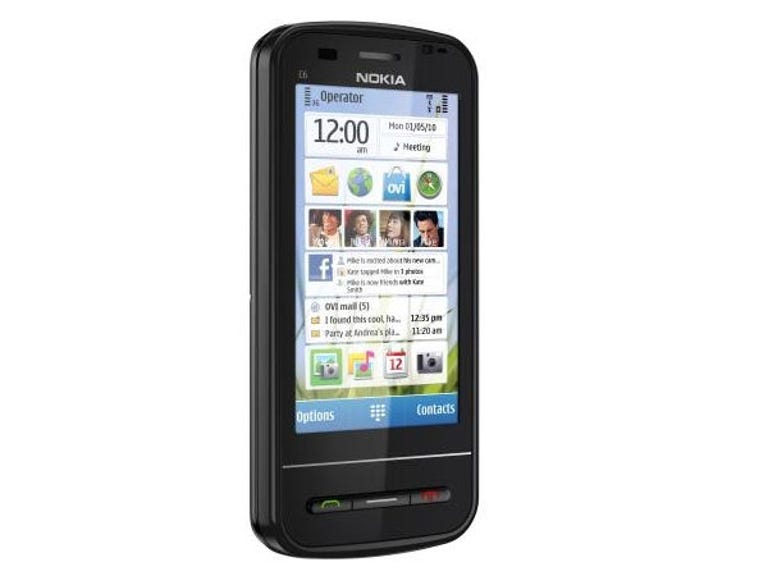 Why You Can Trust CNET
Why You Can Trust CNET Nokia C6 review: Nokia C6
This mid-range Nokia smartphone with slide-out keyboard gets its basics right, but is largely hampered by a sluggish and outdated user experience.
The C6 is similar to the N97 mini in many ways. They run on the same operating system, have the same screen size and are powered by 434MHz processors. The differences? The C6 has a marginally larger footprint, supports Flash Lite 3.1 in the web browser, doesn't have Carl Zeiss optics for the camera and uses the 2mm charger connector.
The Good
The Bad
The Bottom Line
Design
The C6 is a stark reminder of the N97 mini, save that the former doesn't have a tilt screen and is marginally larger. The front fascia is glossy and prone to fingerprint smudges, while the back is made from smooth matte plastic. But what surprised us was how heavy the C6 is (the slider phone tips the scales at 150g). We didn't expect that from a mid-range, mass-market device with plastic as its chief component.

(Credit: CNET Asia)
The C6 is clad in either black or white and you won't find any other colour accents on the handset until you slide out the physical keyboard from under the screen. This is a resistive display, which means you'll need to put a little pressure on the touchscreen before it will register the command. The panel measures 3.2 inches diagonally, supports 16 million colours and has a resolution of 640x360 pixels similar to a number of Nokia devices. The keyboard and directional control pad extend the phone's length considerably, which results in a sizeable gap between the touchscreen and the rectangular Call, End and Menu buttons nestled below.
At the top is where you find a 3.5mm audio jack and micro-USB port. The C6 charges via the 2mm connector found at the bottom edge, and the rim encircling the port lights up in a white glow when connected to a power source. Plugging in the micro-USB cable lets you synchronise with a PC but doesn't juice up the handset. On the right are the volume buttons, keylock and camera shutter, all with decent tactility. At the opposite side is the hot-swappable microSD expansion card slot with support for up to 16GB flash media. Finally, at the back are the on-board speakers and 5-megapixel camera accompanied by an LED flash.
Features
Optimising the home screen to bring useful and relevant content right to the top is one of the yardsticks of a good user interface. On the C6, which is based on the S60 5th Edition platform, there are six place-holders where you can run a gamut of applications and shortcuts. These include time, date, phone profiles, favourite contacts, email headers and application launchers. While it seems like there's a lot going on here, the most useful (and practical) are the ones that let you jump to a program without having to trawl through several layers of menu pages. The visuals look dated because they haven't changed much since the N97. Ticker tape-style mini apps like the ones for Facebook and AP Mobile display too little information to be of use. The same can be said for email headers on the home screen.
It gets worse with the single- and double-tap annoyances. This input method was introduced to maintain compatibility with existing S60 3.x applications. The first tap lets you select, while the subsequent tap executes the command. The user experience here can range from confusion to frustration depending on your tolerance. Given that many competing touchscreen devices offer fluid and logical user interfaces, we're inclined to think the latter. Symbian^3 is supposed to address many of these issues and it can't come soon enough. What we also didn't like were menu options in certain applications which took up precious screen estate and the confusing contextual commands. The latter was especially evident in Ovi Maps.
The C6 supports an array of connectivity options that we've come to expect from mid-range to high-end Nokia smartphones. These include a front-facing camera for video calling, Wi-Fi, HSDPA, Assisted-GPS and Bluetooth stereo. There's also a built-in accelerometer for automatic screen rotation, alarm snoozing and call silencing. The phone's firmware can be updated over-the-air or via the PC software, but do note that the former requires a data connection if you're not on Wi-Fi. So make sure you have already subscribed to a data plan. Holding down the Menu button opens the multitasking manager.
A repertoire of applications is pre-installed and more can be downloaded from the Ovi Store. These include Quickoffice (read-only version), a unit converter, PDF reader, Psiloc World Traveler (paid subscription is required to access all features) and Shazam (full version for 30 days). There are also apps for Facebook, Friendster, Hi5, MySpace, AP Mobile, Bloomberg, ESPNsoccernet, CNN Video and a YouTube player, all of which are pretty self-explanatory. We like Ovi Maps with its complete free drive and walk real-time navigation, never mind that it's not the most user-friendly options around. The web browser doesn't support pinch zooming, but it plays Flash videos directly from the page.
(Credit: CNET Asia)
The C6 has a 5-megapixel camera with an LED flash. It has a minimal focusing distance of 10cm and maximum aperture of F2.4, which give pretty decent depth-of-field in close-up shots. The camera also records VGA-resolution clips at 30fps with digital zoom possible during video capture. Our test pictures were generally pleasing and retained a good amount of details, although the automatic white balance was thrown off on a couple of occasions and resulted in a blue cast in some of our snaps.
Performance
The C6 runs on a 434MHz processor with 128MB RAM and we noticed the phone struggled to keep up, especially when running multimedia-related functions such as opening the image and video galleries. During our review period, we also had to wait a couple of seconds on numerous occasions when we tried to open two or more applications. In-call audio quality was good without any distortion and we could hear the person on the other line clearly. The other party reported likewise.
The 1200mAh Lithium-ion battery is rated for up to seven hours of talk time and 17 days on standby. On average, with push activated for our office and personal email accounts, occasional web browsing and navigating with Ovi Maps, plus light calls and messaging, we could get about two days on a fully charged battery.
Conclusion
The C6 probably won't excite a lot of people and we don't think it was meant to anyway. This mid-range Nokia smartphone with slide-out keyboard gets its basics right, but is largely hampered by a sluggish and outdated user experience. Those looking for a capable QWERTY smartphone without all the bells and whistles may want to consider the C6.
Via CNET Asia
